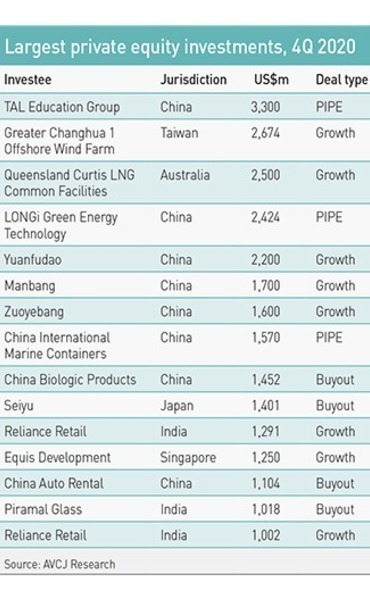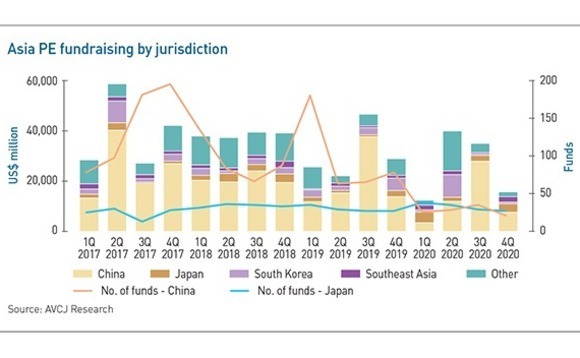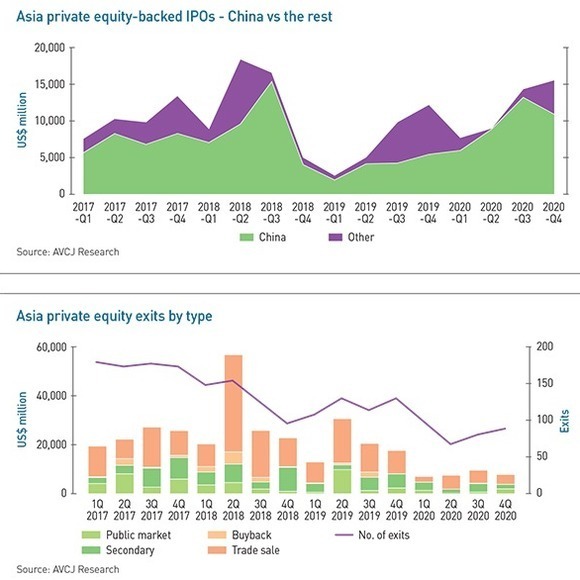
4Q analysis: Growth spurt
Technology-enabled businesses in China and India are the beneficiaries of a resurgence in growth capital deal flow; Japan is the sole stand-out in fundraising; IPOs continue to shine as overall exits struggle
1) Investment: Back to normal?
After the drought came the flood. Asian private equity started 2020 by posting its lowest quarterly investment total in four years. The industry finished it with a record quarterly haul, thanks to a surge in minority and growth-stage activity, chiefly for technology-oriented businesses in China and India.
Investors put $67.2 billion to work between October and December, according to provisional data from AVCJ Research, up from $50.9 billion in the prior quarter. It takes the 2020 total to $198.5 billion, beating the $169.6 billion deployed in 2019. The total could yet surpass $200 billion – as was the case in 2017 and 2018 – as more deal activity comes to light over the coming weeks.

A spike in the fourth quarter of 2019 was replicated in the fourth quarter of last year, with $15.7 billion put to work in growth-stage tech deals. There were three rounds in excess of $1 billion, compared to just one during the preceding nine months. The technology sector accounted for one-third of all private equity investment in Asia, with growth-stage activity contributing nearly one-quarter. This compares to 28% and 11% in the third quarter when the rise of healthcare was a more pertinent trend.
While the technology rebound is a major factor in the Asia growth capital story – 63% of all capital deployed went into minority deals, the second-highest quarterly share in more than a decade – it is not the only factor. There are two nuances worth noting. Both point to a bigger picture issue that was already apparent but is becoming more so: investors are increasingly selective about where they are committing growth capital.
First, the largest transaction from the fourth quarter not being captured in the technology sector statistics. Silver Lake led a $3.3 billion round for TAL Education Group, a US-listed Chinese after-school education provider, a traditionally offline operator with 936 learning centers across 91 cities as of last August. The company falls within the services – non-financial category.
However, every private-sector education business in China has been trying to expand online and COVID-19 accelerated these efforts, based on a recognition that digital habits cultivated during the pandemic will not just ebb away. TAL is no exception. Two more of the 10 largest investments in the quarter went to Chinese pure-play online education providers, with Yuanfudao and Zuoyebang raising $2.2 billion and $1.6 billion, respectively. These are considered technology deals.
Profitability remains a challenge for companies in online education as they offer deep discounts to win market share. But investors appear to be throwing their weight behind the major players, which are looking to expand into new verticals even as smaller rivals – notably those that pursue one-to-one tuition over the large-class model – struggle to survive.
The other nuance is India. Growth capital was a key contributor as overall China deal flow hit $37.6 billion for the quarter, up from $22.3 billion in July-September. It also helped the India total reach $10.8 billion, continuing a hot trend that began in the second quarter. Having secured $9.9 billion for Jio Platforms, a holding company for various digital assets, Reliance Industries raised $6.4 billion for Reliance Retail. Three of those commitments came in the third quarter and the rest in the fourth.
Jio Platforms owns India’s number one mobile carrier, so it is essentially a telecom business. Reliance Retail operates the country’s largest brick-and-mortar retail network. Yet they are united by a common interest in technology, specifically a “new commerce” strategy, whereby Jio Platform will digitalize the demand side (handling orders from consumers) and Reliance Retail will do the same on the supply side (helping merchants embrace technology-led efficiencies). Both hold interests in online retailer JioMart.
Much like TAL, Yuanfudao and Zuoyebang, investors put their money into Reliance Retail because they believe it has the scale to succeed. They were likely also sold on the notion of technology disrupting traditional industries – which is why some tech-driven deals defy being classified as such.
2) Fundraising: The Japan show
Asia private equity fundraising has endured its weakest year since 2014, with $102.4 billion raised over the past 12 months. This compares to $122.5 billion in 2019. The number of partial or final closes is even more dispiriting: approximately 400, less than half the 2019 figure.
Given the travel restrictions imposed because of COVID-19 – which have prevented GPs and LPs from meeting face-to-face, often ruling out anything apart from re-ups – it could have been worse. There are three reasons why it was not: pan-regional funds, US dollar-denominated China venture capital, and Japan. They are the only major strategies to see a year-on-year increase in commitments in 2020; in the case of China VC and Japan, the sums raised represent all-time records.
Exclude renminbi funds from consideration and the Asia total falls to $69 billion (the renminbi space had a difficult year as well, though for different reasons, with capital raised hitting a seven-year low). With that as the baseline figure, these three popular strategies account for 70% of all commitments made. In 2019, their combined share was 45%.
Unfortunately, between October and December of 2020, only one of these strategies attracted a meaningful amount of money in relative terms: Japan. As a result, Asia private equity fundraising came to $15.6 billion across all currencies, the lowest quarterly total in seven years. There were 70 partial or final closes, fewer even than at the depths of the global financial crisis. It’s possible this figure will subsequently be revised upwards, but probably not by enough to alleviate the gravity of the situation.
For the past decade, in any given quarter China has outstripped Japan on fundraising, sometimes by as much as 40-fold. This changed in the first quarter of 2020, with Japan pushing ahead in terms of capital raised and number of closes. Normal service returned thereafter, but Japan took the lead again in the fourth quarter by number of closes. It trailed China by capital raised – $7.6 billion to $3.3 billion – but Japan was the only major market to register an increase in commitments over the previous three months.
Japanese managers were responsible for two of the 10 largest closes and five of the top 25. Polaris Capital Group led the domestic pack, with CEO Yuji Kimura saying Fund V had reached its hard cap of JPY150 billion ($1.4 billion). Meanwhile, Integral Corporation became the second independent Japanese GP since the global financial crisis to surpass $1 billion in fund size, closing its fourth vehicle at JPY123.8 billion. Polaris will become the third, when it announces a final close.
Heading into the final quarter, Polaris and Integral were two of five managers – alongside Bain Capital, T Capital Partners, and J-GIA – seeking a combined $3 billion. It stands as testament to the generally favorable track records in Japan as well as the level of faith in increasing investment opportunities, notably corporate carve-outs.
In the absence of substantial final close from a pan-regional or Chinese GP, NIIF Master Fund, a government-backed Indian infrastructure vehicle, led the quarterly fundraising rankings with $2.34 billion. It was followed by Axiom Asia (a pan-regional mandate, but for a fund-of-funds) and Korea mid-market manager IMM Private Equity. They raised $1.8 billion apiece in their latest vintages.

3) Exits: Still IPOs, still China
Hopes for a resurgence in exit activity were not realized in the final quarter of 2020. Having wallowed at multi-year lows in the first six months of the year as buyers and sellers waited for the outlook to become more certain, proceeds climbed to $9.5 billion in the third quarter, supported by secondary buyouts. They relapsed in the fourth. Trade sales increased slightly in number but fell in value, from $5.3 billion to $3.9 billion. The total for the quarter was $7.8 billion.
This put exits for 2020 in full at $31.8 billion, down from $81.2 billion the previous year. It is the lowest annual total since 2009. The number of transactions worth $1 billion or more fell from 18 in 2019 to four. Only one was a trade sale to a strategic investor; two were sales to other financial sponsors.
For the first time since 2018, when Walmart bought Flipkart, India was the most active geography for exits during the quarter. Just over $2 billion was generated from 30 transactions – out of 89 for Asia as a whole – including seven of the top 25. Three involved private equity firms picking up minority stakes in technology businesses from industry peers.
As for private equity-backed IPOs, China remained the driving force in a strong market. A total of $14.9 billion was raised through 71 offerings during the final three months of 2020, roughly on par with the previous quarter.
China accounted for half the offerings and 70% of the proceeds, including JD Health, which raised $3.48 billion. It was the largest IPO by a PE-backed Chinese company in two years. Thanks to JD Health and a handful of biotech offerings, Hong Kong was the busiest exchange, with Shanghai’s Star Market in third and the New York Stock Exchange in fourth. New York only had two IPOs but online beauty player Perfect Dairy and discount retailer Miniso each raised $600 million-plus.
There was a surprise second place for Australia, which hadn’t seen a sizeable offering supported by a financial sponsor in three years until October. A A$270 million ($192 million) IPO by Adore Beauty, another online beauty start-up, was well received, and this appears to have opened the door for others. About a dozen companies went public in the final quarter, raising $2.2 billion between them. Technology is inevitably the favored sector.
Over the course of 2020, more than 270 PE-backed Asian companies listed, generating proceeds of $45.2 billion. This compares to $29.6 billion from 176 offerings the previous year.

Latest News
Asian GPs slow implementation of ESG policies - survey
Asia-based private equity firms are assigning more dedicated resources to environment, social, and governance (ESG) programmes, but policy changes have slowed in the past 12 months, in part due to concerns raised internally and by LPs, according to a...
Singapore fintech start-up LXA gets $10m seed round
New Enterprise Associates (NEA) has led a USD 10m seed round for Singapore’s LXA, a financial technology start-up launched by a former Asia senior executive at The Blackstone Group.
India's InCred announces $60m round, claims unicorn status
Indian non-bank lender InCred Financial Services said it has received INR 5bn (USD 60m) at a valuation of at least USD 1bn from unnamed investors including “a global private equity fund.”
Insight leads $50m round for Australia's Roller
Insight Partners has led a USD 50m round for Australia’s Roller, a venue management software provider specializing in family fun parks.








